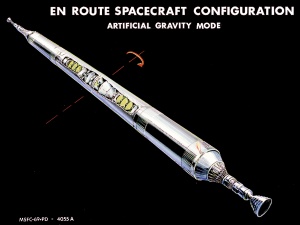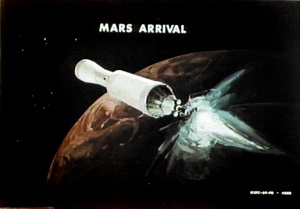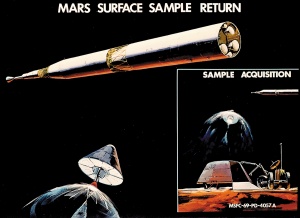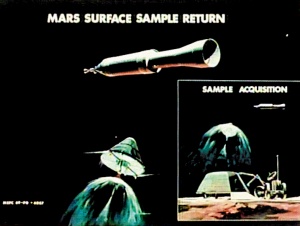Manned Mars Landing by Wernher von Braun Pt 2
From The Space Library
Contents |
MISSION WEIGHT HISTORY
Each completely assembled and fueled vehicle for the 1981 Manned Mars Landing Mission weighs approximately 1.6 million pounds just prior to the Earth orbit departure maneuver. As the vehicle reaches the necessary earth departure velocity and the outer two Nuclear Shuttles are separated, its weight has decreased to 675,000 pounds. Thus nearly 60 of the initial vehicle weight is required for the Earth departure maneuver.
During the Earth to Mars phase of the mission, the only significant weight losses are due to mid-course corrections and life support consumables which amount to about 25,000 pounds. Thus at Mars arrival, just prior to the propulsive braking into Mars orbit, the vehicle weighs 650,000 pounds. While in Mars orbit, all the surface sample return probes and the Mars Excursion Module are deployed. These and other losses reduce the vehicle weight to 380,000 pounds just prior to Mars departure.
Mission Weight History
Mid-course corrections and life support consumables are again lost during the Mars to Earth phase of the trip. Also lost are the probes deployed at Venus encounter. As the vehicle approaches Earth for the final propulsive maneuver, it weighs 190,000 pounds. The total weight returned to earth orbit, consisting of the empty Nuclear Shuttle and the Mission Module (minus expendables) is about 160,000 pounds.
Of the initial weight of 1.6 million pounds in Earth orbit, approximately 1.2 million, or nearly 75%, are propellant.
EN ROUTE SPACECRAFT CONFIGURATION
The forward compartment of the spacecraft is an unpressurized area housing the Mars Excursion Module (MEM), an airlock to provide for pressurized transfer to the MEM and for extra vehicular activities, and unmanned probes. Six Mars Surface Sample Return probes and two Venus probes are carried on each spacecraft.
En Route Spacecraft Configuration
Immediately aft of the airlock is the Mission Module which provides the crew with a shirt sleeve environment, living quarters, space vehicle control capability, experiment laboratories, radiation shelter, etc. The functional areas are distributed on four decks. This compartment is occupied by the crew of six for the entire mission except during the Mars surface activity.
At the aft end of the mission module adjacent to the nuclear shuttle is a biological laboratory where the Mars surface samples are received and analyzed. The biolab is sterilized prior to Earth departure and remains sealed until initial remote analyses of the samples have been accomplished.
EN ROUTE SPACECRAFT CONFIGURATION ARTIFICIAL GRAVITY MODE
The ability of man to withstand a zero gravity environment for periods of time exceeding a few weeks is still an unknown. The Saturn Workshop to be flown in the early seventies will determine man's capabilities in a zero gravity environment for a few months. It will remain, however, for the Space Station to demonstrate man's capabilities for the longer periods required for the Manned Mars Landing Mission.
En Route Spacecraft configuration artificial gravity mode
The option to provide artificial gravity for the crew during the planetary trip must be kept open until conclusive results of man's abilities are established. If early missions indicate the need for artificial gravity the two spaceships can be docked end to end and rotated in the plane of the longitudinal axis during extended cost periods.
Mars Arrival (1969)
MARS SURFACE SAMPLE RETURN
The currently funded Viking Project is aimed at placing soft landers on the surface of Mars in 1973 and perhaps in follow on opportunities. These probes will provide important clues concerning the existence of life on Mars, but will not fully answer the questions as to the possible pathogenic nature of such life. Hence, on the first manned mission, it may be desirable to obtain surface samples prior to the actual landing of man and subsequent contamination of the planet.
Surface samples can be obtained with sterile unmanned probes deployed from the manned spacecraft. The probe would descend from the orbiting spacecraft, land on the Martian surface, automatically gather a sample and return it to the biological laboratory in the spacecraft for analysis. If the analysis revealed no significant biological hazards, man can then proceed to the surface and the samples could be returned to Earth for more detailed analysis, along with the more selective (but perhaps Earth contaminated) samples obtained by man.
To provide a reasonably representative coverage of the various sections of the planet, six surface sample probes are carried in each spacecraft.
Mars Surface Sample Return (1970)
Mars Surface Sample Return (1969)






